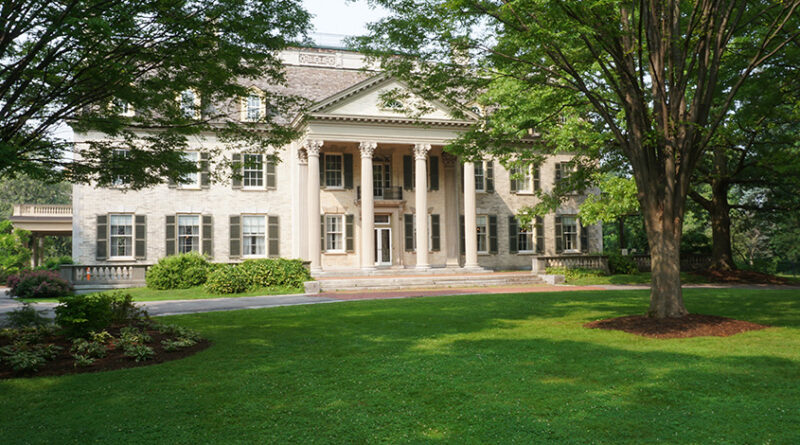Preserving the Legacy of George Eastman
Director Bruce Barnes has overseen the growth of George Eastman Museum’s collection, increased its focus on contemporary photographers and overseen various physical changes to the building
By Mike Costanza
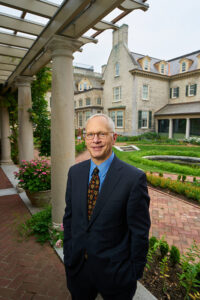
After a long and successful career in business, Bruce Barnes was ready for a change.
“Some men run off with a 24-year-old and some people buy a fast car,” the 61-year-old said. “I decided not to do either of those things.”
Instead, Barnes decided to express his love for museums and the arts by devoting his great energy to a good cause. Oct.1, 2012, he became the Ron and Donna Fielding director of the George Eastman House, now known as the George Eastman Museum. The nonprofit is a leading museum of photography, the cinema and the technologies that have made them possible and continue to do so.
Since he took the George Eastman Museum’s helm, Barnes has helped add rare finds to its collections, improved its capacity to safely store photos and overseen extensive renovations of its physical structure. Not bad for someone who lacks what some might call the right background for the job.
“I’m not a photography person, historically,” Barnes said. “I’m much more of a contemporary art person.”
Barnes was born in Inglewood, California, and raised in Cortlandt, a town in Westchester County. After acquiring a Bachelor of Arts and Ph.D. in economics from the University of Pennsylvania, he turned away from academics to work in New York City, where he held executive positions at such firms as the Ziff Communications Company and the Reservoir Capital Group, and served as the CEO of the Rochester-based online learning company Element K. While heading Element K he regularly traveled to Rochester, where he got to know the George Eastman Museum.
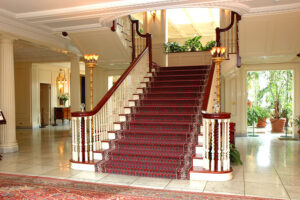 It was in New York City that Barnes met Joseph Cunningham, a Ph.D. student in philosophy. The two grew close, and eventually married. Among other interests, they share a love of art museums — they’ve visited more than 200 of them in the U.S. alone — and of collecting art.
It was in New York City that Barnes met Joseph Cunningham, a Ph.D. student in philosophy. The two grew close, and eventually married. Among other interests, they share a love of art museums — they’ve visited more than 200 of them in the U.S. alone — and of collecting art.
“I’m a very serious collector of American decorative art and design from the period around 1900,” Barnes said, with a grin. “My husband collects works by contemporary, obsessive-compulsive artists.”
Those shared interests led the pair to collaborate on two books on specific forms of art. Cunningham wrote, and Barnes edited, “The Artistic Furniture of Charles Rohlfs.” The award-winning book, which was published in 2008, is a comprehensive examination of the works of Rohlfs, a Buffalo-based turn-of-the-century furniture maker who was one of the most creative furniture designers of that period.
Cunningham and Barnes also joined two other authors to write “The Jewelry and Metalwork of Marie Zimmerman.” The 2011 volume depicts the life and work of Zimmerman, a creator of remarkable early 20th century metalworks.
In addition to engaging in such pursuits, Barnes and his husband have sought to foster interest in the art forms they value through the Leeds Art Foundation. The nonprofit, which Barnes founded and Cunningham heads, collaborates with U.S. museums to generate the appreciation and understanding of circa-1900 American decorative art and design.
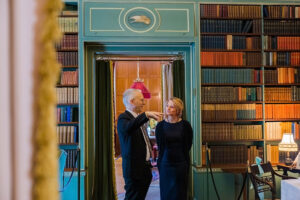
Though such pursuits were rewarding, Barnes eventually felt the urge to give his energy and skills to an art museum. When Anthony Bannon, the George Eastman Museum’s longtime director, decided to retire, Barnes expressed interest in the position.
Kevin Gavagan, a longtime member and former chairman of the museum’s board of trustees, was on the committee that searched for Bannon’s replacement. Barnes’ lack of a background with museums or the arts made him stand out from the other applicants for the job.
“He was an economist; he had worked at running a company; he had a Wall Street background, but he also had a very deep, clear, personal affinity for the arts,” Gavagan said. “This was a strange set of backgrounds, impressive but not necessarily out of central casting for museum director.”
After extensive discussions with Barnes, the committee made its pick for the directorship.
“He kind of came away as not just intriguing, but over time, compelling,” Gavagan said of Barnes. “So, we gave it to him.”
Barnes moved to Rochester to take up his new position, and set out to expand the George Eastman Museum’s collections. Though it had world-class agglomerations of photos, films and photographic and cinematographic technologies, he did not think it was reaching its full potential.
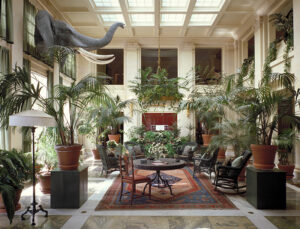 “The institution was clearly not doing as much as, at least in my view, it should be doing with respect to contemporary art photography,” Barnes said.
“The institution was clearly not doing as much as, at least in my view, it should be doing with respect to contemporary art photography,” Barnes said.
To remedy that, Barnes has striven to add to the museum’s holdings the works of contemporary artists who use photography as their medium.
“One of the key things was to make sure that the institution was keeping up with what was considered important that was being made today,” he said.
As part of that effort, Barnes and Paolo Cherchi Usai, who was then the George Eastman Museum’s senior curator of the moving image department, sought to convince well-known South African artist William Kentridge to donate his works to the museum. In 2015, Kentridge presented the masters for all of his films, videos and digital works to the institution.
“He reached the conclusion that the museum was going to be better at preserving the works than any other institution,” Barnes said.
Usai, who is now the museum’s senior curator-at-large and makes his home in Milan, Italy, called the acquisition a “curatorial coup,” and praised Barnes’ for his part in it.
“The acquisition of the complete moving image works by William Kentridge was a highlight of our collaboration,” he said.
Though overseas, Usai continues to work with Barnes on projects of this kind.
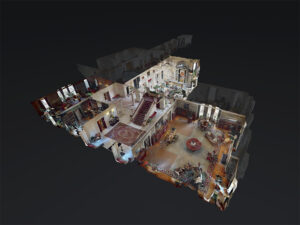 “It is like working with three people at once: a museum administrator, a fellow curator, an inquisitive manager with a flair for detail and razor-sharp logic, under the skin of a suave conversationalist,” he said.
“It is like working with three people at once: a museum administrator, a fellow curator, an inquisitive manager with a flair for detail and razor-sharp logic, under the skin of a suave conversationalist,” he said.
Cunningham and Barnes also co-sponsored an exhibition of some of the works of internationally recognized photographer Judy Glickman Lauder, whose subjects include the Holocaust. “Resistance and Rescue: Denmark and the Holocaust” presents the pictures and stories of Danes who helped thousands of Jews and their relatives escape from Nazi-occupied Denmark during World War II. The photos depict common people who showed uncommon courage.
“We’re talking about a group of people who put their lives at risk to save people who were different from them,” Barnes said. “Ninety-five percent of the Jewish population in Denmark was boatlifted to Sweden.”
Altogether, about 7,200 Jews and 700 of their relatives made it safely to neutral Sweden in 1943. Barnes believes the exhibition’s message about helping others is particularly important today.
“We’ve had this tremendous increase in hate crimes,” he said. “Now is the time where we all need to remind people that they need to be morally courageous.”
While adding to the museum’s collections, Barnes has also sought to safeguard the items it has.
“Two of the collections we have are two of the most challenging things to care for, from an environmental perspective,” he said. “Film is more demanding than basically anything else and photographs are more demanding than other works on paper.”
Unfortunately, when Barnes came on board, the heating, ventilation and air conditioning systems of the museum’s photo and technology vaults weren’t completely up to the task of preserving the items they stored.
“There was too much variation in humidity, the principal problem, and they couldn’t maintain temperatures as needed,” Barnes said.
To remedy the problem, in 2018 the museum undertook a $1.2 million project to replace the storage areas’ HVAC systems. Both vaults can now maintain the optimal conditions for preserving the photographs, negatives and technological devices they store.
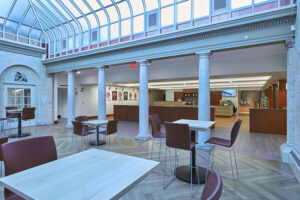 While attending to the needs of the George Eastman Museum’s collections, Barnes has also overseen extensive renovations of its premises. Gavagan has worked with him on a number of infrastructure projects, including the almost $1.7 million renovation of the long colonnade that joins George Eastman’s original mansion and the 1989 addition to the museum.
While attending to the needs of the George Eastman Museum’s collections, Barnes has also overseen extensive renovations of its premises. Gavagan has worked with him on a number of infrastructure projects, including the almost $1.7 million renovation of the long colonnade that joins George Eastman’s original mansion and the 1989 addition to the museum.
“The colonnade was in very rough shape,” Gavagan said. “It was actually designed by George Eastman.”
The renovation project included the replacement of the colonnade’s roof, support structure and floor, the installation of a new climate control system and the erection of a wall of specially treated glass that can stand up to the weather. The wall also provides a great view of the adjoining Schuyler C. Townson Terrace Garden. Barnes was involved every step of the way.
“Bruce was very effective not only in helping to raise the money to make it happen, but the overall management of the project,” Gavagan said. “He’s very detail-oriented.”
Gavagan helped secure a $1 million donation for the project from the late Bruce B. Bates, a longtime museum trustee, The Bruce B. Bates Colonnade opened to the public in 2020.
Gavagan also worked with Barnes on another major construction project, that to relocate the museum’s entrance and give the building a new visitors’ center. Museum patrons first walked through the doors of the $5.75 million Thomas Tischer Visitors’ Center in October of 2020. The center is named after Thomas Tischer, a longtime supporter of the museum who was the largest donor to the project.
Gavagan has continued to work with Barnes on museum projects since then and considers him a good friend.
“He’s working hard, he puts in very long hours, and he’s just a very dedicated, enthusiastic, pleasant guy to work with,” Gavagan said. “I’ve enjoyed it immensely.”
During Barnes’ time as the George Eastman Museum’s director, the nonprofit has invested more than $5 million in the restoration of its mansion and gardens. He recognizes that that work is not finished.
“I expect that over the next five to 10 years, we’ll invest that much again,” Barnes said.
Though he has a home in Rochester, Barnes spends many weekends with his husband in New York City. Even after almost 11 years on the job, he still looks forward to coming to work.
“What we’re doing is deeply satisfying,” he said.
Through the Lens of History
By Mike Costanza
Photos provided by George Eastman Museum
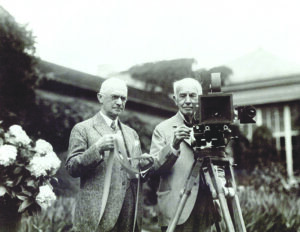
1905
Entrepreneur and photography pioneer George Eastman completes construction of his mansion on Rochester’s East Avenue. The three-story building sat on an 8.5-acre tract that eventually came to include formal gardens, working farmland, greenhouses, stables, pastures and barns.
1948
The University of Rochester donates the mansion and its surrounding property to the museum.
1989
The museum completes the construction of an addition that greatly increases its overall size. The 73,000-square-foot addition includes exhibition galleries, climate-controlled vaults and laboratories for the conservation of photos and the preservation of films.
1932
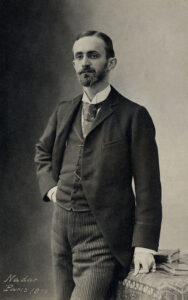
Eastman dies, leaving his 35,000-square-foot home and the property surrounding it to the University of Rochester.
1949
George Eastman House opens. Among all American museums, only two had a photography department and only two that had a film department. The museum had both.
1990
The museum completes a restoration of the mansion’s most important rooms.
1947
The New York State Board of Regents charters George Eastman House, Inc. as an independent nonprofit educational institution. The nonprofit was specifically created as a museum of photography and its associated pursuits and a memorial to George Eastman.
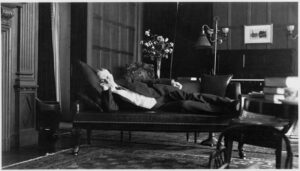
1951
The 500-seat Dryden Theater opens, and begins screening films for the public.
2015
George Eastman House changes its name to “George Eastman Museum.”
Currently, the George Eastman Museum has an annual operating budget of about $9.4 million and employs 83 full-time and 27 part-time employees. About 125 volunteers help make the place function.
For more information on the museum and all it has to offer, go to: www.eastman.org

